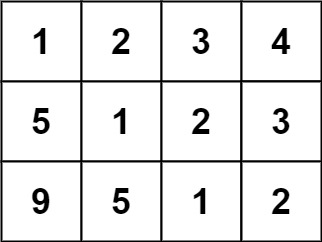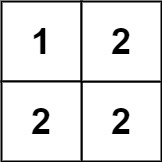- {x}
- Bold Words in String
- Employee Free Time
- Find Anagram Mappings
- Special Binary String
- Prime Number of Set Bits in Binary Representation
- Partition Labels
- Largest Plus Sign
- Couples Holding Hands
- Toeplitz Matrix
- Reorganize String
- Max Chunks To Make Sorted II
- Max Chunks To Make Sorted
- Basic Calculator IV
- Jewels and Stones
- Basic Calculator III
- Sliding Puzzle
- Minimize Max Distance to Gas Station
- Read More...

Toeplitz Matrix
Given an m x n matrix, return true if the matrix is Toeplitz. Otherwise, return false.
A matrix is Toeplitz if every diagonal from top-left to bottom-right has the same elements.
Example 1:

Input: matrix = [[1,2,3,4],[5,1,2,3],[9,5,1,2]] Output: true Explanation: In the above grid, the diagonals are: "[9]", "[5, 5]", "[1, 1, 1]", "[2, 2, 2]", "[3, 3]", "[4]". In each diagonal all elements are the same, so the answer is True.
Example 2:

Input: matrix = [[1,2],[2,2]] Output: false Explanation: The diagonal "[1, 2]" has different elements.
Constraints:
m == matrix.lengthn == matrix[i].length1 <= m, n <= 200 <= matrix[i][j] <= 99
Follow up:
- What if the
matrixis stored on disk, and the memory is limited such that you can only load at most one row of the matrix into the memory at once? - What if the
matrixis so large that you can only load up a partial row into the memory at once?
Solution Explanation
The problem asks to determine if a given matrix is a Toeplitz matrix. A Toeplitz matrix is one where each diagonal from top-left to bottom-right has the same elements. The solution involves iterating through the matrix and checking if this condition holds true.
Approach
The most straightforward approach is to compare each element with the element diagonally above and to the left of it. If any pair of elements doesn't match, the matrix is not Toeplitz.
The code iterates through the matrix, starting from the second row and second column (index 1). It compares matrix[i][j] with matrix[i-1][j-1]. If they are different, it immediately returns false. If the loop completes without finding any mismatches, it means the matrix is Toeplitz, and the function returns true.
Code Explanation (Python as Example)
class Solution:
def isToeplitzMatrix(self, matrix: List[List[int]]) -> bool:
m, n = len(matrix), len(matrix[0])
return all(
matrix[i][j] == matrix[i - 1][j - 1]
for i in range(1, m)
for j in range(1, n)
)-
m, n = len(matrix), len(matrix[0]): This line gets the dimensions of the matrix.mis the number of rows, andnis the number of columns. -
return all(...): This uses theall()function to efficiently check the condition for all elements. The generator expression(matrix[i][j] == matrix[i - 1][j - 1] for i in range(1, m) for j in range(1, n))iterates through the matrix, starting from the second row and second column, and yieldsTrueif the current element is equal to the diagonally top-left element, andFalseotherwise.all()returnsTrueonly if all yielded values areTrue.
Time and Space Complexity
-
Time Complexity: O(m*n), where 'm' is the number of rows and 'n' is the number of columns. The code iterates through the matrix once.
-
Space Complexity: O(1). The solution uses a constant amount of extra space, regardless of the matrix size. The
all()function might use a small amount of stack space for the generator, but this is considered constant in relation to the input size.
The same logic and complexity analysis apply to the solutions provided in Java, C++, Go, and JavaScript. They all achieve the same result using nested loops to efficiently check the Toeplitz property.